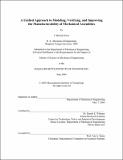| dc.contributor.advisor | Daniel E. Whitney. | en_US |
| dc.contributor.author | Gray, J. Michael (John Michael), 1978- | en_US |
| dc.contributor.other | Massachusetts Institute of Technology. Dept. of Mechanical Engineering. | en_US |
| dc.date.accessioned | 2005-05-17T14:52:29Z | |
| dc.date.available | 2005-05-17T14:52:29Z | |
| dc.date.copyright | 2004 | en_US |
| dc.date.issued | 2004 | en_US |
| dc.identifier.uri | http://hdl.handle.net/1721.1/16671 | |
| dc.description | Thesis (S.M.)--Massachusetts Institute of Technology, Dept. of Mechanical Engineering, 2004. | en_US |
| dc.description | Includes bibliographical references (p. 247-256). | en_US |
| dc.description | This electronic version was submitted by the student author. The certified thesis is available in the Institute Archives and Special Collections. | en_US |
| dc.description.abstract | The goal of a design engineering organization is to design products that satisfy customers. Reaching this objective is dependent, among other things, on five parameters: the customer expectations, the target percentage of satisfied customers, the nominal performance of the design, the variability in the manufacturing processes, and the sensitivity of the design performance to such variability. This work presents a unified methodology that is amendable to computer implementation for modeling these five parameters for products that are primarily mechanical in nature. The validity of this methodology is subject to five major assumptions: the nominal performance of the design matches the performance expected by the customer, the set of customer expectations can be represented completely by a set of geometric relationships and tolerances between features in the assembly, the degradation in product performance is due solely to quantifiable variability or mean shift in the assembly geometry, the variability in each geometric relationship is independent of the variability in any other geometric relationship, and any compliant parts in the assembly can be accurately modeled as sets of rigid parts connected with linearly-compliant joints. The assembly model is developed using a combination of Screw Theory, Network Theory, Homogeneous Transformation Matrices, and Probability Theory. It is shown how this model can be used to verify the manufacturability of a mechanical assembly design. It is also shown how the model and the results obtained from it can be used to improve the level of manufacturability of a design if it is found to be unacceptably low. To validate the effectiveness and accuracy of the methodology, an automated version written for Matlab® | en_US |
| dc.description.abstract | (cont.) was used to model and analyze the manufacturability of an engine valvetrain. The results of this case study are presented and compared to results using existing industry-standard tools. Several suggestions for improving the manufacturability of the valvetrain are also proposed and discussed. | en_US |
| dc.description.statementofresponsibility | by J. Michael Gray. | en_US |
| dc.format.extent | 282 p. | en_US |
| dc.format.extent | 1663464 bytes | |
| dc.format.extent | 1663244 bytes | |
| dc.format.mimetype | application/pdf | |
| dc.format.mimetype | application/pdf | |
| dc.language.iso | eng | en_US |
| dc.publisher | Massachusetts Institute of Technology | en_US |
| dc.rights | M.I.T. theses are protected by copyright. They may be viewed from this source for any purpose, but reproduction or distribution in any format is prohibited without written permission. See provided URL for inquiries about permission. | en_US |
| dc.rights.uri | http://dspace.mit.edu/handle/1721.1/7582 | |
| dc.subject | Mechanical Engineering. | en_US |
| dc.title | A unified approach to modeling, verifying, and improving the manufacturability of mechanical assemblies | en_US |
| dc.type | Thesis | en_US |
| dc.description.degree | S.M. | en_US |
| dc.contributor.department | Massachusetts Institute of Technology. Department of Mechanical Engineering | |
| dc.identifier.oclc | 56802469 | en_US |
